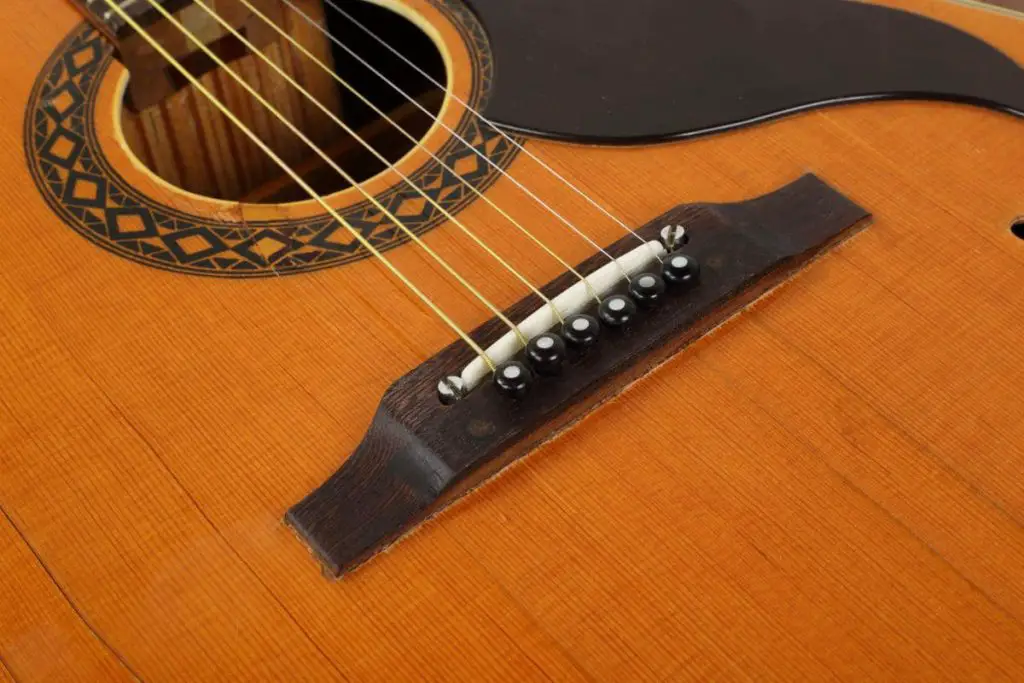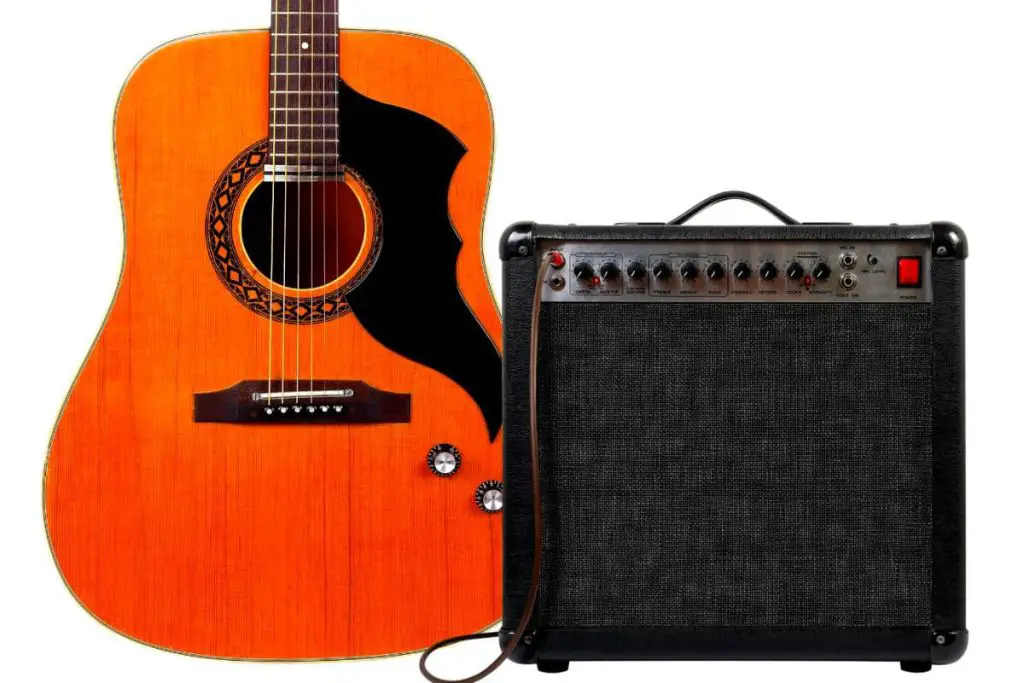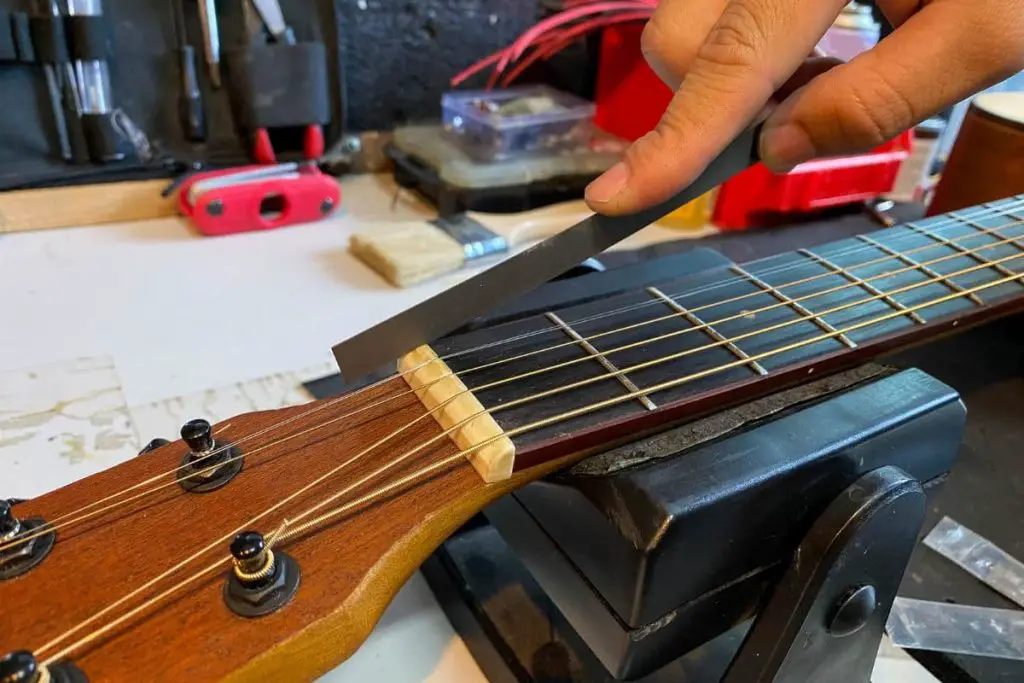Guitars are supposed to sound great when they’re tuned. Most people attribute the poor sound quality to the tuning of the instrument, but that’s always the case. If your guitar is in tune and it still sounds a bit off, you’re not alone. There are plenty of explanations for why a tuned guitar might not sound the best.
Your guitar sounds bad when in tune due to fretting mistakes, poor intonation, or worn strings. It could also be affected by malfunctioning pickups, buzzing chords, loose parts, and more. Monitor the guitar’s action, nut, bridge, fretboard, and strings to keep it sounding good when it’s tuned.
In this article, we’ll break down all of the reasons your guitar doesn’t sound good, even when it’s tuned. We’ll also cover several solutions to make your guitar sound as good as it used to.
👇😀👇NOTE👇😀👇
If you want to find out what my recommended guitar gear is, then here is what I recommend on Amazon:
- Fender Cutaway Acoustic-Electric Guitar Bundle (MY FAVORITE GUITAR)
- Snark SN-8 Super Tight All Instrument Tuner (Easiest Tuner I’ve Used😏)
- 6 String Acoustic Guitar Capo (Best CAPO for quick changes)
- Dunlop Max Grip 1.0mm Nylon Picks (Thick Guitar Pick So You Don’t Lose Grip!)
- Universal Guitar Stand (Cheap & Minimalist Guitar Stand I Recommend)
- Levy’s 2″ Wide Quick Adjust Guitar Strap (Best Guitar Strap For Any Level)

Fretting and Strumming Mistakes
Beginners often make a lot of mistakes while fretting, strumming, and fingerpicking. It’s not always the guitar’s fault, so consider your technique if it seems like something’s off. A couple of millimeters can make a world of difference when it comes to fretting chords, picking strings, and so on.
Review this quick list of common fretting mistakes:
- Failure to press the strings hard enough: If you don’t put enough pressure on the strings with your chord hand, they’ll buzz and wear down. Every string vibrates when it’s plucked. These vibrations rattle against the fret bars rather than sending the clean, smooth vibrations to the bridge.
- Touching the fret bar rather than the fretboard between the bars: It’s important to place each finger between the bars that you want for the fret. For example, your finger should be between the second and third bar on the fretboard if you want to play the second fret. Placing your finger on the bar will cause buzzing.
- Strumming all of the strings with every strumming pattern: Believe it or not, you don’t have to play all six strings when you play the guitar. In fact, many chords sound much cleaner and clearer if you only play four or five strings. For example, a D chord is often played with the 1st through 4th or 5th string (leaving out the bass strings).
- Holding chords incorrectly: If you don’t know where your fingers need to go for each chord, you’ll obviously encounter sound issues. However, proper finger placement depends on the size of your hands. If you have small hands, you’ll need to use different fingers for the same chords as people with large hands.
- Strumming too hard or too soft: When you strum too hard, you’ll risk damaging the strings and causing tuning issues. When you strum too soft, you won’t cause enough vibrations for some of the strings to make the proper sound. It’s a matter of taking the time to gain muscle memory.
These errors go away with practice and time. Learning how to hold and strum your guitar will drastically improve your skills, reducing the odd sounds that come whether or not it’s tuned. Mastering your hand placement will also help ward off unwanted fret buzzing, humming, and other strange sounds.
Poor Intonation
According to Guitar Gear Finder, poor intonation is a leading cause of why guitars can sound bad when they’re tuned. A guitar’s intonation shows how well it holds its tune from the top to the bottom of the fretboard. If your guitar sounds fine at the top and bad at the bottom, it likely has bad intonation that needs to be fixed.

These five issues cause poor intonation:
- The action is too low. If the action is too low, the strings will be extremely easy to press. They could also be a bit looser than they need to be. Loose, low-action strings buzz against the fretboard, causing unwanted intonation issues. They could also compress, which means they won’t be as flexible.
- The action is too high. If the action is too high, the strings will have too much tension. This increased level of tension requires more pressure, which means you might not be able to press the strings against the fretboard. Higher action gets harder to deal with as you get closer to the higher frets on the neck.
- The truss rod is bending the guitar’s neck. Most guitars have a truss rod that goes down the middle of the neck. You can adjust the truss rod by using an Allen key to rotate the adjustment nut at the base of the fretboard. Adjust the truss rod until the guitar’s neck is as flat as possible without buzzing the strings.
- The nut isn’t adjusted for the strings. If the nut is too low or high, it’ll change the action. As you read above, your guitar’s action changes everything about the way your instrument sounds. Make sure the nut is centered above the fretboard at the base of the headstock, then don’t forget to secure it with an adhesive.
- The bridge or saddle is misaligned. Much like the nut, your guitar’s bridge and saddle need to be centered and secured. However, they sit at the base of the strings. The bridge is what holds the guitar strings with pins to send vibrations through the sound hole. The saddle elevates the strings, ensuring they have proper action.
Old, Worn Strings
If your guitar’s strings are beaten up, they won’t sound good. Old strings sound tinny, buzzy, and all-around unsettling. They shouldn’t look corroded, rusty, discolored, or dull. Most guitar strings last a few weeks to a couple of months before they need to be replaced. Fortunately, almost all guitar strings aren’t too expensive.
Ernie Ball’s Earthwood Medium-Light Guitar Strings are perfect for guitarists of all experience levels. They combine the brightness of light strings with the subtle warmth of medium strings. They’re primarily made of bronze and run with a 12-to-54-gauge setup (0.012” at the high E and 0.054” at the low E). You can also choose from many other gauges if you prefer.
Malfunctioning Pickups
Guitar pickups malfunction all the time. Whether you have a high-end pickup or a low-quality modification, there’s a good chance you’ll have to adjust it every now and then. Pickups are small electronic devices that let you amplify and record your music through various other devices. However, they have a lot of issues that can change your guitar’s sound.
So, why can a pickup make your guitar sound bad even if it’s tuned?
- The pickup is loose inside of the guitar. Most pickups are secured with screws. Make sure the screws are tight and not stripped. Some people use wood glue to ensure the screws don’t wobble or loosen. Also, don’t forget to inspect the wires inside of the guitar. Secure them to prevent them from rattling when you strum or fingerpick.
- You’re not using the right cables for the pickup. Some cables have one band, whereas others have multiple bands. Using the wrong cable for the pickup will alter the instrument’s electrical signal. This could change the way it sounds or completely prevent the guitar from being amplified or recorded.
- The audio interface between the pickup and your laptop isn’t converting the signal properly. While the pickup is an essential component for many guitarists, the audio interface can’t be overlooked. If you have a low-end or malfunctioning audio interface, it won’t sound good coming out of the other end.
- You might be using a low-end pickup. Pickups come in all shapes, sizes, and qualities. Make sure you get the pickup that fits your price range. However, keep in mind that a low-quality pickup connected to a high-quality amplifier won’t sound the best. You’ll need every part of the process to be the same quality for the best results.
- The pickup is too close to the strings. When the pickup is too close to the strings, it’ll rattle around the guitar’s body. These vibrations will change from circular motions to ovular motions, changing the intonation and making your guitar sound bad, even if it’s tuned and has new strings.
If you’ve checked all of these issues and the pickup still sounds strange, it might be time to get a new one. Keep in mind that your guitar’s primary parts will last a lot longer than a pickup. Most guitar bodies can last several decades, but you’ll need a new pickup every few years if you use it all of the time.
Buzzing Chords
If your chords are buzzing, it means something’s wrong with the strings. It could be due to user error, though many guitar part problems alter the strings’ performance. The good news is that any buzzing string issue is solvable. You don’t need to replace the guitar, but you might need to replace a couple of parts.

These are some of the primary reasons your chords buzz:
- Your hands aren’t placed properly on the guitar. Improper placement means your hands could be touching the wrong part of the strings. However, it could also mean that your palm is touching the strings with your chord hand. Make sure you’re not accidentally barring or touching the frets you don’t want to touch.
- The strings are damaged. Strings get damaged when you play them too hard, they’re stretched too far from excessive tuning, or when they’re stored improperly. Never open a package of guitar strings until you’re ready to use them. The second the package is opened, the strings start to oxidize and the clock starts ticking.
- The fret bars are too sharp for the strings. The bars between each of the frets can corrode and scratch your guitar strings. Make sure none of them touch the strings when you play a chord (other than the intended contact between the bar in front of the compressed fret). You can file them if needed.
- Your guitar might have low action. Low action will make the strings buzz because they’re much closer to the fretboard than they should be. The strings should sit between 2.0mm to 2.8mm above the fretboard. If they’re too close, they’ll buzz and make contact with several bars on the fretboard.
- The guitar’s strings are dirty. Dirty strings ruin the guitar’s vibrations, which directly influences the sound quality. Furthermore, having dirty strings makes it hard for you to press the chords without slipping or sticking to the strings. Clean your guitar strings with string cleaning solution, not vinegar, essential oils, and other DIY products.
Once you find out why your strings are buzzing, you can figure out if anything else is wrong with the guitar. For example, it could have to do with the electrical components (such as the aforementioned pickup problems). If you use an amplifier with your guitar, consider some of the common concerns in the following section.
Amplifier Problems
Six String Acoustic explains your guitar might be fine; it could be the amplifier that’s at fault. Amplifiers control most of the sound that comes out of the instrument because it’s all you’ll hear. Most amps let you control the bass, treble, gain, mid-range, and many other sounds. If you don’t know how to control these features, it could drastically reduce the guitar’s sound quality.

Sadly, it might also be that the amp has low-quality speakers. Cheap amps (or old ones) aren’t nearly as clear and crisp as high-end amps. It could also be that the amplifier is too small and doesn’t resonate or produce as much sound as you’d prefer. Make sure you adjust the gain, treble, and bass to see which combination sounds best with your guitar.
Loose Guitar Parts
Loose parts on your guitar will ruin its sound. If you notice your guitar sounds much different than it used to (and it’s tuned), it might be time to tighten everything up. Almost every guitar part supports the strings, which means they’ll be directly impacted if something isn’t as secure as it was out of the box.
Here’s a list of loose guitar parts that need to be repaired or replaced:
- Nut: The nut at the top of the fretboard can loosen from natural wear and tear, incorrect string slotting, or tightening the strings too much. Fortunately, you can use wood glue or glue specifically designed for guitars to secure the nut and stop it from moving around the neck and headstock.
- Bridge: The bridge at the bottom of the strings can loosen over time. Tightening the strings too much can put too much strain on the bridge, so it’s important to tune them correctly. Once the bridge comes off, you might need to bring it to a repair shop to have a new one properly installed to prevent intonation issues.
- Saddle: The saddle on top of the bridge loosens from natural wear and tear, much like the nut. However, it can be pulled out of the bridge if you remove all of the strings. Make sure the saddle is placed exactly where it was before you removed it. The saddle’s slight angle ensures the action doesn’t go awry.
- Tuning pegs: The tuning pegs shouldn’t have too much pressure on them if the nut does its job properly. However, a loose nut or overly tight strings can shift the tuning pegs. Make sure you tighten the tuning peg screws underneath each of the pegs. If they get stripped, you might need to use bigger screws.
- Bridge pins: Bridge pins are thin pins that hold the strings into the guitar’s bridge. If they get loose or worn, they won’t be able to support and secure the strings. To replace the bridge pins, unwind the corresponding tuning peg and pull the pin out with pliers or a pin-pulling tool for guitars. Pop the new one in its place and you’ll be all set.
Once you tighten all of these parts, you shouldn’t hear any rattling. Keep in mind that you might also need to tighten the pickup if it’s bouncing around the guitar. If you think there’s still something wrong with one of the grooved components, read on for a few quick tips and tricks.
Slotting Issues
Your guitar strings fit into a series of slots and grooves. Guitar Answer Guy claims that a slight difference in these slots can make your guitar sound bad. You’ll find these slots in the nut and saddle on the guitar. They sit at the top and base of the strings, securing them to the tuning pegs and the bridge.

The good news is that you can file the nut and saddle. If they’re too high or narrow, they won’t accommodate large strings. We suggest taking it to a guitar shop if you’ve never filed the nut or saddle. These parts are fragile and can break under too much pressure. Once they’re filed, string the guitar and you’ll be surprised by how much better it sounds.
Final Thoughts
Playing the guitar should be relaxing, engaging, and exciting. If you tuned your guitar, you shouldn’t have to deal with bad intonation or buzzing strings. Try some of the suggestions mentioned above to find out why your guitar doesn’t sound as it should, then apply the corresponding solutions.
👇😀👇NOTE👇😀👇
If you want to find out what my recommended guitar gear is, then here is what I recommend on Amazon:
- Fender Cutaway Acoustic-Electric Guitar Bundle (MY FAVORITE GUITAR)
- Snark SN-8 Super Tight All Instrument Tuner (Easiest Tuner I’ve Used😏)
- 6 String Acoustic Guitar Capo (Best CAPO for quick changes)
- Dunlop Max Grip 1.0mm Nylon Picks (Thick Guitar Pick So You Don’t Lose Grip!)
- Universal Guitar Stand (Cheap & Minimalist Guitar Stand I Recommend)
- Levy’s 2″ Wide Quick Adjust Guitar Strap (Best Guitar Strap For Any Level)
Related Posts:

